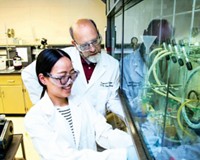Advertisement
Grab your lab coat. Let's get started
Welcome!
Welcome!
Create an account below to get 6 C&EN articles per month, receive newsletters and more - all free.
It seems this is your first time logging in online. Please enter the following information to continue.
As an ACS member you automatically get access to this site. All we need is few more details to create your reading experience.
Not you? Sign in with a different account.
Not you? Sign in with a different account.
ERROR 1
ERROR 1
ERROR 2
ERROR 2
ERROR 2
ERROR 2
ERROR 2
Password and Confirm password must match.
If you have an ACS member number, please enter it here so we can link this account to your membership. (optional)
ERROR 2
ACS values your privacy. By submitting your information, you are gaining access to C&EN and subscribing to our weekly newsletter. We use the information you provide to make your reading experience better, and we will never sell your data to third party members.
Education
Personal Protection: Whither Lab Coats?
by Jyllian N. Kemsley
June 28, 2010
| A version of this story appeared in
Volume 88, Issue 26

A recent letter to the editor (May 24, page 4) complained that a Journal of Chemical Education advertisement in C&EN showed three students working in a lab without lab coats (March 22, page 50). “Anyone who works in industry will tell you that basic personal protective equipment includes goggles, a lab coat, and gloves,” wrote Haiming Zhang, a process chemist at Lexicon Pharmaceuticals.
COVER STORY
Personal Protection: Whither Lab Coats?
Not so, say instructors and safety professionals involved in undergraduate teaching labs. Although eye protection and closed-toe shoes seem to be required at all schools all the time, gloves and lab coats are considered more on a case-by-case basis. The crux of the issue is that undergraduate labs are frequently designed—often through the use of microscale techniques—either to be safe or inexpensive, or both.
Students at Arkansas’ Hendrix College, for example, might do a glucometer experiment that involves soaking split peas in water overnight and then breaking down the sugars using Beano, a dietary supplement used to prevent gas, says Shelly Bradley, the campus chemical compliance director. A ketone reduction experiment requires a mere 2 μL of 2,6-dimethylcyclohexanone with 5 mg of sodium borohydride in 0.3 mL of water, methanol, 95% ethanol, vodka, or rubbing alcohol. The labs are equipped with autodispensers so that the students often aren’t even handling bottles of stock solutions.
Similar experiments and equipment are in place at other schools. And, instructors and safety experts say, a “one size fits all” approach to personal protective equipment (PPE) doesn’t teach students what they need to know. “Having people wear latex gloves all the time is one of the habits that cost us Dr. Wetterhahn,” says Ralph Stuart, environmental safety manager at the University of Vermont, referring to a fatal mercury-poisoning incident at Dartmouth College, in New Hampshire. In 1996, a few drops of dimethylmercury penetrated the latex gloves worn by chemistry professor Karen Wetterhahn, who died as a result the next year. Instead of latex, she should have worn plastic laminate gloves under long, heavy-duty ones (Appl. Occup. Environ. Hygiene 2001, 16, 233).
“Mindlessly following a set of protocols may not be appropriate for exactly what you’re doing,” says Edward Miller, a chemistry professor at the State University of New York (SUNY), Plattsburgh. He’d rather see the issues and concerns discussed explicitly with students so that they understand why and when to wear protective equipment and what kind.
One school that does require lab coats for all undergraduate labs is the University of California, San Diego. UCSD didn’t always mandate this type of PPE. Instead, the school had a dress code to ensure that skin was appropriately covered in case of spills. But the dress code was difficult to enforce, says Sheila M. Kennedy, an environmental health and safety specialist in UCSD’s department of chemistry and biochemistry. “Our explanation of what was appropriate attire was a huge paragraph and had to be constantly changed” as fashions evolved, she says.
Now, the rule is simple: Lab coats and closed-toe shoes are mandatory in the labs. “We got very little pushback” to the new requirement, Kennedy says. “The students really seem to like the lab coats.” Students must purchase the coats themselves and can typically store their coats in a lab drawer during courses, although the coats have to go home between quarters and the department has no laundry facilities.
SUNY Plattsburgh’s Miller acknowledges that there is a tension between designing labs to use safe or minimal materials and the goal of producing chemists capable of working in real-life environments. A student who has done a microscale distillation likely won’t be prepared to do a more traditional one involving 100 mL of material, he says. But Miller also sees a distinction between running a lab that might include a lot of nonchemistry majors—where the goal might be to teach the concepts rather than the techniques—and a course for majors.
Ultimately, Miller says, departments need to find a way to balance the various concerns. “If we’re going to train chemists,” he says, “somewhere along the line they’re really going to need to do a regular distillation and learn how to deal with the issues associated with that kind of activity.”




Join the conversation
Contact the reporter
Submit a Letter to the Editor for publication
Engage with us on Twitter